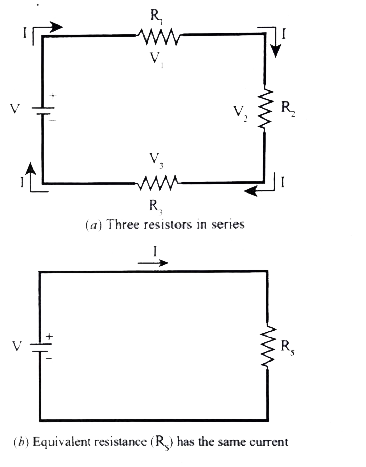Explain the equivalent resistance of a series and parallel resistor network. Solution in Tamil
Resistors in series: When two or more resistors are connected end to end, they are said to be in series. The resistors could be simple resistors or bulbs or heating elements or other devices. Fig. (a) shows three resistors Rp R2 and R3 connected in series.

The amount of charge passing through resistor R] must also pass through resistors R2 and R3 since the charges cannot accumulate anywhere in the circuit. Due to this reason, the current I passing through all the three resistors is the same. According to Ohm’s law, if same current pass through different resistors of different values, then the potential difference across each resistor must be different. Let V1,V2 and V3 be the potential difference (voltage) across each of the resistorsR1,R2and R3 respectively, then we can write V1=IR1,V2=IR2 and V3=IR3. But the total voltage V is equal to the sum of voltages across each resistor.
V=V1+V2+V3
=IR1+IR2+IR3
V=I(R1+R2+R3)
V=I.R3
Where RS is the equivalent resistance.
RS=R1+R2+R3
When several resistances are connected in series, the total or equivalent resistance is the sum of the individual resistances as shown in fig.
Topper's Solved these Questions
Similar Questions
What are the differences between Coulomb force and gravitational force ?
View SolutionCalculate the electric field due to a dipole on its axial line and equatorial plane.
View SolutionHow do we determine the electric field due to a continuous charge distribution ? Explain. Electric field due to continous charge distribution
View SolutionThe equivalent resistance of n identical resistors connected in parallel si x. If the resistors are connected in series, the equivalent resistance would be.
View SolutionThe equivalent resistance of two resistors connected in series 6Ω and their parallel equivalent resistance is 43Ω. What are the value of resistance?
View Solutionश्रेणी तथा समान्तर - क्रमो में प्रतिरोधों के संयोजन का तुल्य - प्रतिरोध ज्ञात करना ।
View SolutionExplain the equivalent resistance of a series and parallel resistor network.
View SolutionDefine effective resistance of a number of resistors connected in a series or parallel combination
View SolutionExplain the equivalent resistance of a series and parallel resistor network.
View SolutionExplain the equivalent resistance of a series and parallel resistor network.
View SolutionFind the equivalent resistance of the two resistors connected in parallel series.
View SolutionThe equivalent resistance of network of three 2Ω resistors can not be
View SolutionThe equivalent resistance of network of three 4Omega resistors can not be
View SolutionExplain series connection of resistors. Derive equation of equivalent resistance (RS).
View SolutionThe equivalent resistance of a series combination of two resistors is '9 Omega' and the equivalent resistance of a parallel combination of the same two resistors is 2Ω. Find the resistances of the resistors.
View Solution
